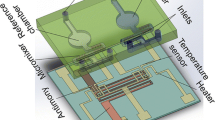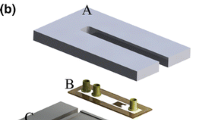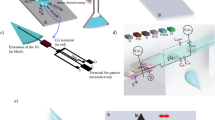Abstract
We report on a micromachined silicon chip that is capable of providing a high-throughput functional assay based on calorimetry. A prototype twin microcalorimeter based on the Seebeck effect has been fabricated by using IC technology process steps in combination with micromachined postprocessing techniques. A biocompatible liquid rubber membrane supports two identical 0.5×2 cm2 measurement chambers, situated at the cold and hot junction sites of a thermopile. The thermopile consists of 666 aluminum/p+-polysilicon thermocouples. The chambers can house up to 106 eukaryotic cells cultured to confluence. The advantage of the device over microcalorimeters on the market, is the integration of the measurement channels on chip, rendering microvolume reaction vessels, ranging from 10 to 600 µl, in the closest possible contact with the thermopile sensor (no springs are needed). Power and temperature sensitivity of the sensor are 23 V/W and 130 mV/K, respectively. The small thermal inertia of the microchannels results in the short response time of 70 s, when filled with 50% of water.
Biological experiments were done with cultured kidney cells of Xenopus laevis (A6). The thermal equilibration time of the device is 45 minutes. Stimulation of transport mechanisms by reducing bath osmolality by 50% increased metabolism by 20%. Our results show that it is feasible to apply this large-area, small-volume whole-cell biosensor for drug discovery, where the binding assays that are commonly used to provide high-throughput need to be complemented with a functional assay.
Solutions are brought onto the sensor by a simple pipette, making the use of an industrial microtiterplate dispenser feasible on a nx96-array of the microcalorimeter biosensor. Such an array of biosensors has been designed based on a new set of requirements as set forth by people in the field.
Similar content being viewed by others
References
H. Baltes and O. Paul, Sensors and Materials 8, 406 (1996).
P. Bataillard, E. Steffgen, S. Haemmerli, A. Manz, and H.M. Widmer, Biosensors and Bioelectronics 8, 89 (1993).
L. Bousse, Sensors and Actuators B34, 270 (1996).
L. Briggner and I. Wadso, J. of Biochem. and Biophys. Methods 22, 101 (1991).
G. Buckton and A.E. Beezer, Int. J. of Pharmaceutics 72, 181 (1991).
B.Z. Chowdry, A.E. Beezer, and E.J. Greenhow, Talanta 30, 209 (1983).
P. Monk and I. Wadso, Acta Chemica Scandinavica 22, 1842 (1968).
S. Thoren, M. Monti, and B. Holma, Biochimica et Biophysica Acta. 1033, 309 (1991).
Author information
Authors and Affiliations
Rights and permissions
About this article
Cite this article
Verhaegen, K., Simaels, J., Driessche, W.V. et al. A Biomedical Microphysiometer. Biomedical Microdevices 2, 93–98 (1999). https://doi.org/10.1023/A:1009989402932
Issue Date:
DOI: https://doi.org/10.1023/A:1009989402932




